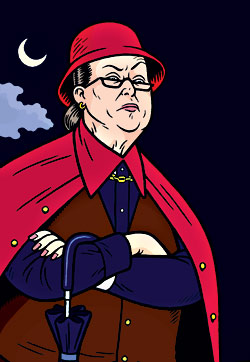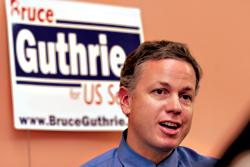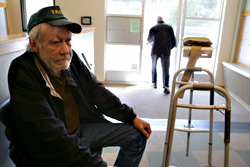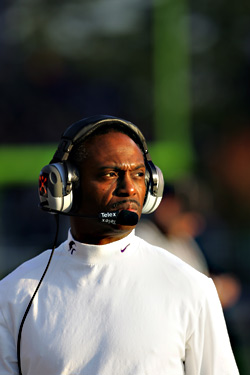A couple of weeks ago, I interviewed Roger Valdez, director of tobacco prevention for Public Health– Seattle & King County. He is in charge of Seattle-area enforcement of the statewide smoking ban approved by voters in November. I call him the tobacco czar.
We were talking about how enforcement was working out, including the 25-foot rule. In the midst of our chat, Valdez said something remarkable.
“Americans think they have a lot of rights they really don’t have. Smoking is one of those things where people think they have the right to smoke, but you don’t.” He used “you” in the plural. “You have no right to smoke. It’s an addiction. It’s something you should see a doctor about.”
He went on to tell me that people have no right to smoke even in their private residences.
“The condo association can ban it, and you have no legal recourse,” Valdez said.
Today, your local bar; tomorrow, your home.
Oh my.
A City Fit for The Amish?
While other Western U.S. cities like San Francisco, Portland, and Las Vegas have few restrictions on strip clubs and exotic dancing, Seattle was behaving a whole lot like Salt Lake City. In Seattle, you cannot even drink liquor in a strip club.
Has it really come to this? Government officials—well paid by taxpayers, excellent health care benefits and pensions included—talk this way to taxpaying citizens, and we stand aside because bureaucrats like Valdez “know” how we should behave, even behind closed doors?
You hear all kinds of hyperbole from the lips of nanny statists these days. In Seattle, it ties in nicely with the city’s long tradition of hyperearnest citizens, people the critic H.L. Mencken called “uplifters.” Those are the folks who “know” what’s good for everyone else and have no tolerance for anything they consider against the rules of clean living. They seek to ban whatever activity they don’t like. That’s often the way of social conservatives, the people who helped bring about Prohibition in the last century and today want to ban a woman’s right to choose or eliminate gay rights. They know what’s good for everyone because, often, their religious conviction tells them so.
But of late, liberals and progressives around the country are acting just as religious, except many wrap their arguments in the secular prophecy of public-health officials and all-knowing advocacy groups. Progressives are going after “rights” connected to behavior they consider unhealthful. They want to ban smoking completely. They want to so limit alcohol consumption that the speakeasy, once again, becomes reality. They want to ban gun ownership. They want to control what people eat. In Seattle, nannies like Mayor Greg Nickels want to drive strip clubs out of business. And, if progressives cannot get their way through education and mass-media campaigns, then they will resort to the ballot box, coercion, and in the case of Washington state government, a call for social discrimination.
There is a lot of talk about rights in the air right now. Last week, Samuel Alito, President George W. Bush’s nominee to the Supreme Court, was grilled by a Senate committee about just what rights Americans—especially women—enjoy in our society. Do Americans have an absolute right to privacy, for example? That’s not a minor question—it is at the core of abortion rights.
But all rights are local, when push comes to shove. It’s the local authorities who will enforce the nanny laws. The cops will be busy in Seattle now that the city’s historic progressive puritanism is back in full scold mode. Right now, Seattle has a suite of new restrictions that make Rain City look like a no-fun zone to the rest of the world.
The most prominent of these is the smoking ban, the most restrictive in the nation. No indoor smoking in any business and no outdoor smoking within 25 feet of the entrance to any publicly accessible building. The ban affects the entire state, but in densely packed parts of the city, the 25-foot rule creates a dicey situation for smokers: They literally have to stand in the street to smoke legally. But more on that in a moment.
Last fall, Nickels and the Seattle City Council imposed new restrictions on the city’s four strip clubs. The next day, hundreds of newspapers around the world picked up a wire story that made “world-class” Seattle come off like Amish country.
But then, the city has been trying to prevent outward signs of civic wildness for years. The City Council last month banned certain beers and wines favored by the poor. The city has tried to ban posters on power poles—shot down in court in 2002—and when Mark Sidran was city attorney in 1993, he tried to impose no-sitting laws to sweep the homeless from city sidewalks.
And let’s not forget the city’s ridiculous All-Ages Dance Ordinance, which is meant to choke off the all-ages music scene, or the city’s club task force, which many people in the club scene read as an attempt to hassle clubs for the 21-and-over crowd.
Disneyland Meets the Barbary Coast
Four years ago, Nickels came into office as Mayor Pothole. He begins his second term as Mayor Killjoy. In September, the council, at Nickel’s urging, passed a new ordinance for strip clubs as part of replacing the 17-year-old moratorium on new strip clubs being built in the city. It’s a move that sounds soothing and moral, but addresses claims that really don’t exist.
The city has four strip clubs and has long prevented new ones through arcane legal maneuvering. In addition, a local ordinance prohibited strippers from touching patrons—which is to say performing lap dances—or from exposing their genitalia unless they were dancing onstage. While other Western U.S. cities like San Francisco, Portland, and Las Vegas have few restrictions on strip clubs and exotic dancing, Seattle was behaving a whole lot like Salt Lake City. In Seattle, you cannot even drink liquor in a strip club.
The new strip-club ordinance will prohibit dancers from coming within four feet of a patron. Patrons who wish to tip a stripper for her work won’t be allowed to hand her cash directly or engage in the traditional act of sliding greenbacks into a garter belt. In Nannytown, patrons will have to place monetary rewards in a tip jar, just like at Starbucks. The new law will also require that the city’s strip joints be lit as brightly as the inside of your local QFC.
The new law is not in effect because a coalition of strip-club owners called Seattle Citizens for Free Speech collected enough signatures to force a vote by citizens sometime this year. The City Council gets to decide whether the measure will go before voters in a low-turnout election early this year or if it will be on the ballot for the September primary or November’s general election. I was curious why a city that claims it’s sophisticated cannot brook the idea of strippers grinding on men’s and women’s laps in dimly lit clubs. Why is a protected free-speech activity something the city would even want to regulate?
Deputy Mayor Tim Ceis describes the city’s approach as responding to “allegations of unlawful acts in the clubs which contribute to a sense of public nuisance.”
Seattle police claim that the existing clubs are scenes of prostitution, but in the last five years, the city has not rung up prostitution convictions against anyone at a Seattle strip club (see “It’s a Hard Job,” Oct. 12, 2005). A “sense” of nuisance, perhaps, but not necessarily a real one.
Not everyone buys the city’s claims. “Really, this is about the type of city we would like Seattle to be,” says Tim Killian, manager of the pro-strip-club campaign. “The things the city is trying to shut down is out of step with the urban, modern, progressive city Seattle says it is.”
Last month, Nickels announced a new plan for managing the strip-club menace: creating a zoning law so that new clubs—allowed under a recent federal court ruling—would be forced to locate on 310 acres of industrial land due south of Safeco Field. The concept sounds bizarre if you didn’t grow up around here. Any new clubs would be banished to well south of downtown, and lap dancing would still be banned. It’s almost as if the mayor wants to create a Disneyfied version of the Barbary Coast.
In December, Nickels also got something of a wake-up call from voters. There were signature gatherers— nondancers—standing in the rain downtown wearing “Keep Seattle Sexy” signs. They collected 35,000 petition signatures within one month to repeal the four-foot rule, more than twice the number required.
Let them Drink Microbrews!
On another front, nanny statists are trying to solve a real problem—too many street drunks, too many police calls—by restricting the rights of low-income residents.
Last month, the City Council approved what it calls “alcohol impact areas” in the Central District, Capitol Hill, Belltown, and the University District. As soon as the move is approved by the state’s Liquor Control Board, these areas will join Pioneer Square in banning the sale of such staples of the drinking poor—those would be the homeless and low-income folks—as Olde English 800, Night Train, and Schlitz Malt Liquor.
The ordinance’s language is clearly discriminatory, aimed at regulating a social class’ ability to cop a cheap buzz. It specifies that any beer having an alcohol content over 5.7 percent (Budweiser and the like generally run 5 percent; malt liquors around 6 percent) and costing less than 4 cents per ounce cannot be sold in any establishment.
How’s that discriminatory? If you can afford to pay more than 4 cents per fluid ounce for beer, then you can still walk into a grocery store, corner market, or bar and buy beer as strong as you like. On Capitol Hill, for example, QFC stocks winter ales such as Pyramid Brewing’s Snow Cap and Maritime Pacific Brewing’s Jolly Roger. Each has an alcohol content of about 8 percent, making them 33 percent stronger than what the poor are now allowed to buy in the same part of town. You’ll pay $7 or more per six-pack for the privilege, which works out to about 10 cents per fluid ounce minimum. What’s more, almost every bar on the Hill serves microbrewed imports along the same line. In the bar, those beers start at $3.50 for a pint, or about 22 cents per fluid ounce.
The mayor’s office claims that the ban only covers 8 percent of the city. True, but it just happens to be where many of the city’s low-income people live. Isn’t this the kind of elitism and classism that earnest Seattle liberals always decry?
The lone council member to oppose the ban was Richard McIver, who argued that the move would simply push street drinkers into other parts of the city. Council members such as Nick Licata and Peter Steinbrueck said they recognized the inherent discrimination but instead sided with area homeowners.
Ceis says he understands the discrimination concern to a point.
“But I point out the other dynamic,” he says. “We’ve got an industry designing products to exploit street alcoholics.”
Nannyism’s Poster Child
The big dog in the nanny trend is the smoking ban. Approved by voters in November, the ban tries to address secondhand smoke but has already led to a sinister, stigmatizing strain of nannyism that smacks of mission creep by public-health officials.
In this, the poster child is King County’s Roger Valdez.

When Valdez and I finished our recent conversation (and full disclosure here, I am a smoker), I looked at notes from an interview I did with him last October, during the campaign for I-901, the smoking-ban initiative. At the time, the tobacco czar assured me that the 25-foot rule would be no problem, despite the claims of some business owners and citizens to the contrary.
“Only if smoke is going inside the establishment” would Valdez, a former smoker, bring the hammer down.
“The whole thing is to create clean indoor air, not in stopping people from smoking on the sidewalk. We aren’t interested in going and writing tickets for a guy standing outside the door. That’s what some people want the public to believe. They want you to believe we are extremists. That’s baloney.”
But Valdez has changed his tune. Earlier this month, he enthused about seeing clerks race out of their stores to shoo away smokers within 25 feet of their business’ doors, as if they had suddenly been deputized to police the sidewalk.
I asked Valdez if his crew of enforcers could take action against businesses that refused to enforce the 25-foot rule. He said they would if they received complaints from the public.
So what’s the standard of proof that there is a violation?
“We don’t have to prove anything,” Valdez said. “If we get a complaint of smoke coming in from outside, you have to show by clear and convincing evidence that smoke isn’t coming inside.”
By Valdez’s logic, the sketchiest complaint made to his department is sufficient evidence of a violation to trigger enforcement from the public-health department. Indeed, the department has already visited several local establishments to enforce the 25-foot rule.
And what’s the objective standard that smoke is drifting into a business—you know, the kind of evidence that would stand up in court? Is it a nosy neighbor, a self-appointed hall monitor claiming that they smelled smoke in the vicinity of a coffeehouse?
“I don’t know how they are going to show that,” he said. Ever confident that all Seattleites will obey the 25-foot rule, Valdez predicted that such a case wouldn’t hit the courts because everyone knows what the law means and knows “how to comply.”
Two weeks ago, Valdez filed papers to fill the vacancy created when former City Council member Jim Compton stepped down last month. City Council members left him off the list of finalists Jan. 17.
Turning Smokers into Pariahs
It’s a measure of how far-reaching the public-health community has gotten on secondhand smoke that the state now has a Web site and ad campaign instructing viewers to shun and discriminate against smokers.
Not that smokers are so popular these days. Last November, I-901 was approved by voters 63 percent to 37 percent, an electoral wipeout for nicotine junkies. Gov. Christine Gregoire gained political points from this kind of sentiment when, as the state’s attorney general, she negotiated the so-called master settlement with Big Tobacco in the late 1990s.

Last fall, as smoking-ban advocates campaigned for I-901, the state Department of Health rolled out an aggressive $2.1 million campaign targeting smoking and smokers. The campaign includes television ads, bus placards, billboards, and a Web site.
The ads feature a series of doll heads, each with something awful looking such as a dead rat or a dead fish in their mouths. “Kissing a smoker is just as gross,” says the campaign’s Web site, www.ashtraymouth.com. The campaign and Web site do not contain science-based information about hazards linked to smoking, as you might expect. Instead, they promote the idea that both smoking and smokers are just plain gross.
On the Web site, visitors are encouraged to play a virtual game. In it, one doll tosses items like rats at another doll, letting the rats explode on the target’s body. After the game is over, a caption appears over the target’s head. In one case, a caption read, “Hi. I’m as gross as a smoker.” In another case, a caption said something even more aggressive.
“This tastes like $#@, but it’s better than smoking,” it reads. The phrasing clearly implies “shit.”
Tim Church, communications director for the Department of Health, oversees the state’s antismoking campaigns. “It’s pretty in your face,” he says of the campaign.
He defends the campaign, although he admits that the state has no science-based information to establish that a rat tastes the same as tobacco smoke. So why is the state encouraging nonsmokers to shun smokers and to avoid kissing them?
“We certainly do not want to encourage the shunning of any population,” he says. “We don’t want anyone to discriminate against another member of our society.
“It’s not about the person, it’s about the behavior. We’re not saying smokers are gross. We couldn’t do that.”
Church says the Ashtraymouth campaign, comprising roughly 25 percent of $8 million a year in taxpayer monies spent by the department on antismoking messages, is targeted at adolescents and young teens. He admits that the campaign is seen by every age group, however.
Asked about the “shit” caption, Church said he was unaware of its presence. Seattle Weekly provided the department with a screen shot of the panel. Later that day, Church ordered the department’s ad agency, Seattle’s Sedgwick Rd., to remove the fecal caption. It’s hard to understand how the campaign isn’t encouraging shunning and discrimination, since the rhetoric and symbols of the campaign are plain for all to see. Going after the act of smoking while claiming you aren’t after smokers is about like saying murder is a crime but you aren’t implying that murderers are criminals.
“This is so bizarre,” says Radley Balko, a policy analyst with the Washington, D.C.–based Cato Institute, after looking at the state’s site. “It’s beyond parody.” Balko tracks nanny-state issues for the libertarian nonprofit.
In his opinion, the ad campaign clearly paints “smokers as being the dregs of society.” Balko also says, “It just seems like an effort to make pariahs of smokers.”

So what pushed the Department of Health to resort to bald-faced castigation?
Church says it’s because the department found that smoking rates weren’t dropping quickly enough, so the department and its ad agency conducted focus groups with youngsters. The youngsters told the department that its recent ads (“Tobacco Smokes You”) weren’t edgy enough and that kids had tuned them out.
I asked Church what kinds of youth were in the focus group helping the state decide where to take its ad campaigns.
“I don’t want to stereotype kids,” he said, but then he told me they had chosen kids presumed to be at high risk for bad behavior. “Are they getting bad grades? Do they have people smoking at home? Do they have tattoos already? We’re looking for things that might be considered risky behavior, making them susceptible to other risky behavior.”
I cannot wait to see the inevitable state ad campaign warning about the dangers of tattoos.
Last week, the state Department of Health began an even more aggressive ad campaign, dubbed “Take It Outside.” In television commercials and radio spots, among other places, adult smokers will be advised by a state agency not to smoke inside their own residences. Church justifies it by saying that it’s intended to protect children.
That sounds like the justification floated by conservatives when they want to censor free speech or ban gays from teaching: We must protect the children!
On another state Web site, www.unfilteredtv.com, the state instructs citizens how to change laws related to smoking. As a general rule, state agencies are not supposed to advocate for legal changes. That’s the province of elected officials.
Church defends the department’s approach.
“It’s not about getting laws passed,” he says. “We’ve got strong laws. It’s about educating kids so they can make a difference if they want to, for instance, if they think a park should be made smoke-free.”
Somewhere in Seattle, I sense an ad agency is drawing up a proposal for that media campaign already.
What About Secondhand Pot Smoke?
Nanny statism doesn’t happen in a vacuum, of course. Voters approve laws like the smoking ban and vote party killers like Nickels and City Council member Jan Drago into office, as they did last fall.
You have to wonder what voters pay attention to, however.
Smoking-ban backers, for example, knew very well that businesses don’t control the sidewalks in front of their establishments when they crafted I-901. They knew that there was a whole public right of way—namely sidewalks—where they proposed to pit neighbor against neighbor and business owner against customer in a weird urban test of wills.
Back in October, Nick Federici of the American Lung Association, a major backer of the ban, said he was mildly concerned over how voters would respond to the 25-foot rule in the initiative, but that smoking-ban advocates had voter data showing that they’d get the measure through on the “ick factor” alone. The ick factor is at the core of most nanny-state laws.
Strippers? Ick. Malt liquor? Double ick.
And ickiness was at the core of why hundreds of thousands of Washington smokers got voted out of bars and pretty much off the sidewalks by a bunch of soccer moms and their uptight husbands. How is it that a bunch of people who are in bed by 10 p.m., who go out maybe once a week, get to trump another’s rights to drink whiskey and smoke cigarettes in a bar at midnight?
But those weren’t the only moral scolds voting for I-901. Many of the votes for the measure came from people who also smoke marijuana and who two years ago voted to make marijuana enforcement the least priority of the Seattle police. I-75, as the measure was known, basically operated on this logic: “Dude, we know weed is illegal. But we like it and choose to smoke it. So we are going to tell law enforcement to not pay attention to state statutes and federal laws on pot. Just leave us alone in our private dwellings.”
I only wish I were exaggerating about this electoral dynamic. In recent weeks, I have encountered many voters who say they smoke pot but voted for the smoking ban. Typical stoner logic.
But I wonder how these same people feel now that both the state and King County have made it clear that they don’t believe anyone has a right to smoke in their own residences. Smoke is smoke, right?
Presumption is the Coin of the Realm
But, of course, the nannies are after presumed ickiness all over America these days. And public-health departments are rapidly turning away from their traditional mission of public education and bacteria control to become power brokers in civic life. They seek to regulate how restaurants prepare baked goods in New York City. Earlier this month, New Jersey banned all indoor smoking (except in the gambling mecca of Atlantic City), and Chicago’s ban on smoking in bars and taverns took effect Jan. 16.
It’s like a Mormon fell in love with a Baptist and the two gave birth to a public-health official.
In San Francisco, citizens and politicians are so caught up in an orgy of uplift that last November they banned gun ownership and are trying to ban tobacco smoking from all public parks.
What’s stunning to me is how far the antitobacco forces have gotten on banning smoking in bars and outdoors with little scientific evidence of harm. Last fall, I asked I-901 backers and public-health officials if they had scientific data establishing the level of harm arising from secondhand smoke in bars or from smoking within 25 feet of an establishment’s door. Each of them admitted they had no such data.
Instead, they responded by calling the ban a workers’ rights issue and the 25-foot rule a presumed safe distance. That’s a hell of a presumption, but in Seattle presumption is the coin of the realm, politically.
Let me be presumptuous in return. What gives people who think smoking is icky the right—hell, the nerve—to have their social preferences rule every establishment in the state, sidewalks included? Why did they want to hang out where I smoked if they didn’t like smoking in the first place?
Some Seattleites, no doubt, think such measures as the smoking ban and the four-foot rule at strip clubs are necessary to prevent civic rot. But, if you are thoughtful about these things, you’ll recognize that strip clubs, smoking in bars and in front of coffee shops, and kids listening to hip-hop and punk and raging with their friends line up nicely with Seattle’s self-image as a progressive, inclusive world-class city.
Because Seattle claims to be a world-class city (just ask Greg Nickels), a hub of commerce and culture that will entice the “creative class” from around the world and make the city famous for far more than coffee, grunge rock, and buggy operating systems. But the way things are going, Seattle will indeed be famous—known far and wide as Salt Lake City on the Sound.
I lived in Salt Lake City for five years. You don’t want to live there. It’s not a fun place.









